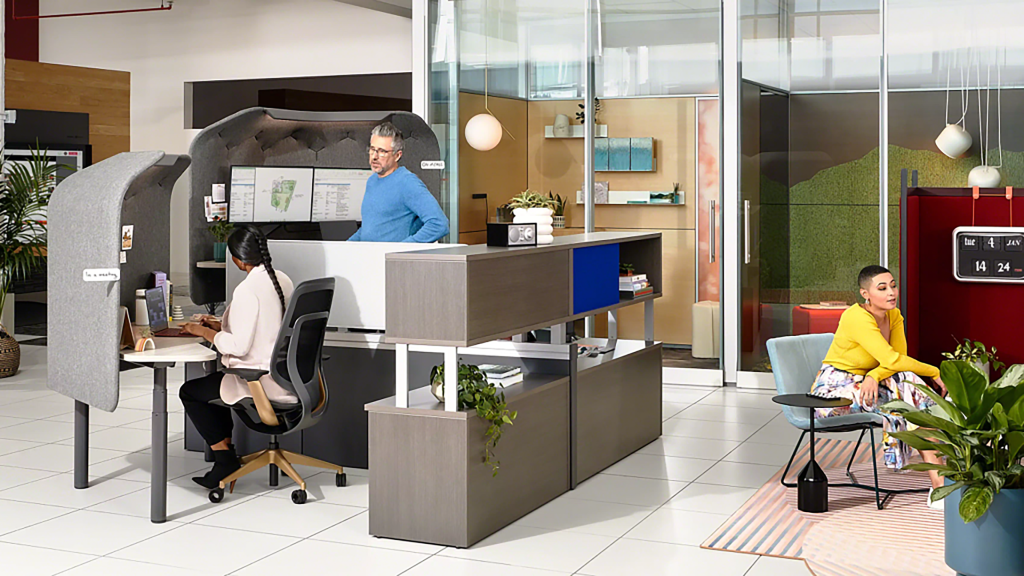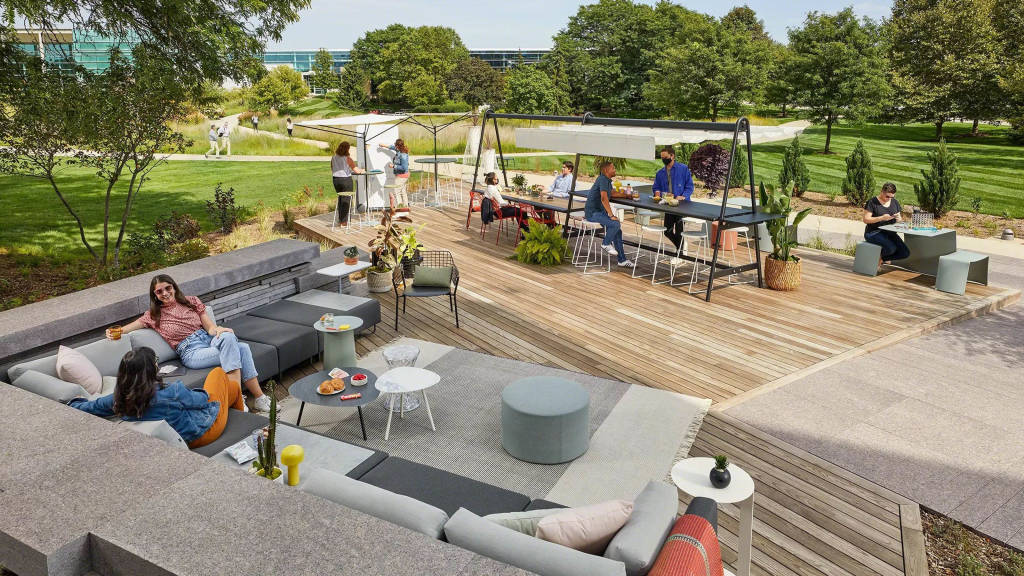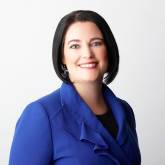SHRM + Steelcase Share Hybrid Work Strategies
Experts in HR and organizational strategy tackle the talent crisis, purpose, trust and return to office.
In the past two years, people have been on a rollercoaster of emotions. Organizations have been hit on all sides with massive problems to solve including a talent crisis of epic proportions. By all accounts, leaders are searching for solutions with the best of intentions. Yet, McKinsey research suggests raising pay and offering remote work are not enough. People expect more. So, what really matters to people?
To find out, Katie Pace, Steelcase global communications director, hosted an expert panel to answer real questions during a recent webinar (watch now).
Our experts:
- Jill Dark, vice president of Talent Futures, Steelcase
- John Hughes, principal with Applied Research and Consulting, Steelcase
- George Rivera, senior vice president of enterprise and commercial partnerships, Society of Human Resource Management (SHRM)
Katie Pace: Can you all give us a snapshot of how you’re working today?
George Rivera: At SHRM, we have about 500 people working with us and we also help shape the ideas for HR departments across the globe. We reopened our Alexandria, Virginia office back in June 2020, but we’ve had some stops and starts in between then and now. We’ve managed to do it in a successful way without a single workplace transmission since opening up.
Jill Dark: I’m in Grand Rapids, Michigan. We’ve been in the office pretty consistently for some time now with people choosing to stay home when case rates were higher. The biggest update for us is we’ve removed our mask mandate on this campus and we’ve really seen an uptick in the number of people on campus since then.
John Hughes: Customers have a broad range of approaches. A lot of them have come back to the office, but not everybody is back. Some haven’t come back and others that haven’t yet set a date. Interestingly enough, well over 70% of companies are implementing a hybrid strategy. But, I find organizations are getting return to office and hybrid confused and intermingling their messaging when they are two different things.
KP: What’s causing “the great resignation” and what can organizations do about it?
GR: Over the last few years, people have reevaluated how their work and their life come together. We’re seeing people search for work that fulfills their values and gives them a sense of purpose. Our new research says 41% of people are searching for a new job or planning to in the next few months. And, seven out of 10 executives are seeing less qualified people applying for roles which is creating a lot of friction for leaders.
JD: Our brains are wired to seek certainty and autonomy. With so much disruption impacting every aspect of our lives, we have limited ability to provide certainty, so we focus on providing clarity instead which helps our brains narrow the field of certainty. When it comes to returning to the office and autonomy, having too little control could push people away. I believe part of what is driving the great recession is that choosing who you work for is one of the only areas people have complete control over right now. But, too much autonomy will leave people wondering if they belong and if their decisions are the correct choice. We have been focused on creating intentional autonomy, which is about giving our employees some degree of input and choice.

JH: Senior leaders are addressing a number of foundational issues. At the top of the list is flexibility — giving people choice about when and where people work. Organizations are feeling pressure to compete for talent when it comes to offering hybrid work. Another key element is the loss of relationships and trust. Many new employees have never been face-to-face and veterans have been apart for some time now. And, leaders are focused on culture and connection to the purpose of the organization. There’s no single strategy, but I have seen a series of linked strategies to maintain and build culture, make changes to process, technology and space, and offer a range of services to better support people.
Explore new global research on hybrid work and see findings from 11 countries.
Download the Steelcase Global Report
KP: How can we do a better job of approaching equity in the hybrid workplace?
GR: It’s an important question and it starts with understanding the situation. SHRM research says more than one-third of women say remote work allows them to stay in the workforce. But at the same time, women in particular have seen a reduction in the opportunity for career growth, pay raises and peer-to-peer learning. Being physically present can make or break a career trajectory. So, it’s a complicated topic and one organizations need to be aware of.
JD: We believe that talent is the only truly renewable resource in any company. In fact, we believe people are infinitely renewable because we continue to grow and develop throughout our lives. We renew our talent by investing in them. One of the simplest ways to invest in people (and create equity) is to give them visibility and access to opportunity. Some examples — we have a corporate goal of posting the vast majority of jobs internally, we partner with external learning vendors to provide on-demand access to learning and we have invested heavily in expanding our wellbeing offerings. Right now, we’re updating our onboarding and performance management systems with employee experiences in mind.
KP: How can we start to rebuild social capital and trust as people come back together, but work in a hybrid way?
JH: For many people, work-from-home days are filled with back-to-back video calls. Casual interactions that are so important to relationship and trust development — which is really the lubricant of innovation — have really suffered. There’s no simple fix. But I’m hearing organizations talk about needing to be very deliberate, starting with teams and making sure they physically get together, socialize and rebuild relationships. Organizations also need to consider a change management plan. For many people, coming back to the office is a bigger change than when they had to go home. And finally leaders need to walk the walk. If they want people back in the office, they need to model that as well.
GR: One thing we try to encourage individuals to understand is the importance of vulnerability. It’s easier to be that stoic leader on camera talking about what should happen next at work than to talk about what’s happening all around us. Another important note is that of social change. One of the greatest prerequisites to trust is if an organization is impacting issues people care about — climate change, economic inequality, the upskilling and reskilling of workers. Over 50% of people said these things were crucial to them and companies aren’t doing enough.

KP: Our research shows 87% of people will spend some amount of time in the office moving forward. How have you helped offer people a more comfortable return to office?
JD: Part of investing in people’s wellbeing is processing the shared trauma of the pandemic. We created a reflection exercise for anyone in-person or virtual. We asked employees to add sticky notes outlining their feelings related to grief or loss, and gratitude and hope. Something amazing happened. Our employees shared very personal and heartfelt messages of real struggles and gratitude which had three positive impacts. First, anyone who wanted to participate had a new positive shared experience of belonging. Second, we were able to anonymously surface real challenges and publicly address them by posting resources to address those challenges. Lastly, people could cognitively offload their grief, feel as if they were not alone and reinforce a sense of community.
KP: The workplace needs to change from being a mandatory destination to being a place people want to go — in essence it needs to earn people’s commute. How are you talking to customers about this shift?
JH: Often what organizations don’t recognize is that hybrid represents a huge spectrum. Too often, I see companies aligning on a hybrid position very quickly and moving forward without studying their people, looking at the data, and considering alternative solutions.
Another thing that needs to be considered is that when people were sent home, there were a lot of things in offices that people didn’t like — a lack of privacy, for example. And people suddenly found they can mitigate some of those things at home.
If employers don’t recognize what objections to the office are and create an opportunity for people to come back to something better, they run the risk that people will vote with their feet.
I also see organizations looking at hybrid from a cost containment perspective. But you have to consider the impact on your culture. A New York Times article summarizes a lot of the mistakes people made implementing hybrid 20 years ago. They found large numbers of people working from home for long periods of time resulted in serendipitous interactions falling off, loyalty and affiliation dropping, and a negative impact on innovation. If you’re not conscious about the potential pitfalls of hybrid, you could end up with negative consequences that are very difficult to do anything about.

KP: What do HR professionals need to know when it comes to how the physical environment can help them achieve their goals?
GR: Nobody is so deeply steeped into the knowledge of what is happening with people right now than human resources professionals. HR is trying to solve for mental health and wellbeing, and collaboration and connection which leads to innovation. These are significant HR and workplace challenges. We’re seeing organizations are changing their physical environment to help make progress around these goals. Amazon is a great example. They are building a new HQ2 right up the road from us in Virginia and are designing their building to address these significant issues. Human resources must be part of these conversations more so than ever before.
JD: Space can play a pivotal role in culture. A guiding question my team asks when we build experiences is: what do you want people to believe and feel. Be ruthless about ensuring your spaces signal and shape the type of culture you want for your organization.
AUDIENCE POLL RESULTS
(Approximately 1,579 number of people participated in the live poll during the webinar.)
Tell us what best identifies your role.
36% – Architect & designer
21% – Real estate and facilities management
20% – Other
12% – Corporate strategy & leadership
9% – Human resources
2% – Information technology
How often are you going into the office right now each week?
29% – I’m still working from home
24% – 2 days or less
26% – 3-4 days
20% – 5 days
How much time each week do you expect to spend in the office moving forward?
7% – None
34% – 2 days or less
38% – 3-4 days
18% – 5 days
4% – Unsure
How would you describe people’s connection to your organization’s culture in the last two years?
17% – Stronger than ever
54% – Okay. But not as strong as it once was.
19% – Not great. It’s eroded over time.
10% – Unsure
If your organization is changing the way work gets done, are you also rethinking the workplace and work experience?
54% – Absolutely – we’ve already started
26% – Yes – this will be addressed soon
14% – Not sure yet
6% – I doubt we will make changes
How has the role of human resources professionals changed at your organization over the last year when it comes to workspace strategy decisions?
37% – Increasing influence
34% – Consistent influence
9% – Decreasing influence
19% – No influence
What’s the biggest challenge when it comes to the talent crisis right now?
48% – Engaging and keeping people
26% – Attracting people
14% – Developing people
6% – Onboarding people
5% – Maintaining productivity

Jill Dark is an applied futurist, focused on creating the conditions that unlock potential and prepare individuals, teams and the organization for the future. She serves as vice president of Talent Futures at Steelcase.

John Hughes established Steelcase’s Workplace Strategies Consulting group and is a principal in with our Applied Research and Consulting practice. He has more than 20 years of consulting and advisory experience and has led major workplace strategy efforts throughout the Americas, Europe and Asia-Pacific. For much of the last 10 years, he has focused his consulting activity primarily on hybrid workplace projects which integrate behavior, space and technology.

After spending 15+ years leading one of the nation’s largest HCM organizations focused on talent business development, George Rivera joined SHRM to build and scale SHRM’s new B2B business. Over the last 18 months, George and his team have built SHRM Enterprise Solutions, a unique value proposition for Fortune 1000 organizations.


